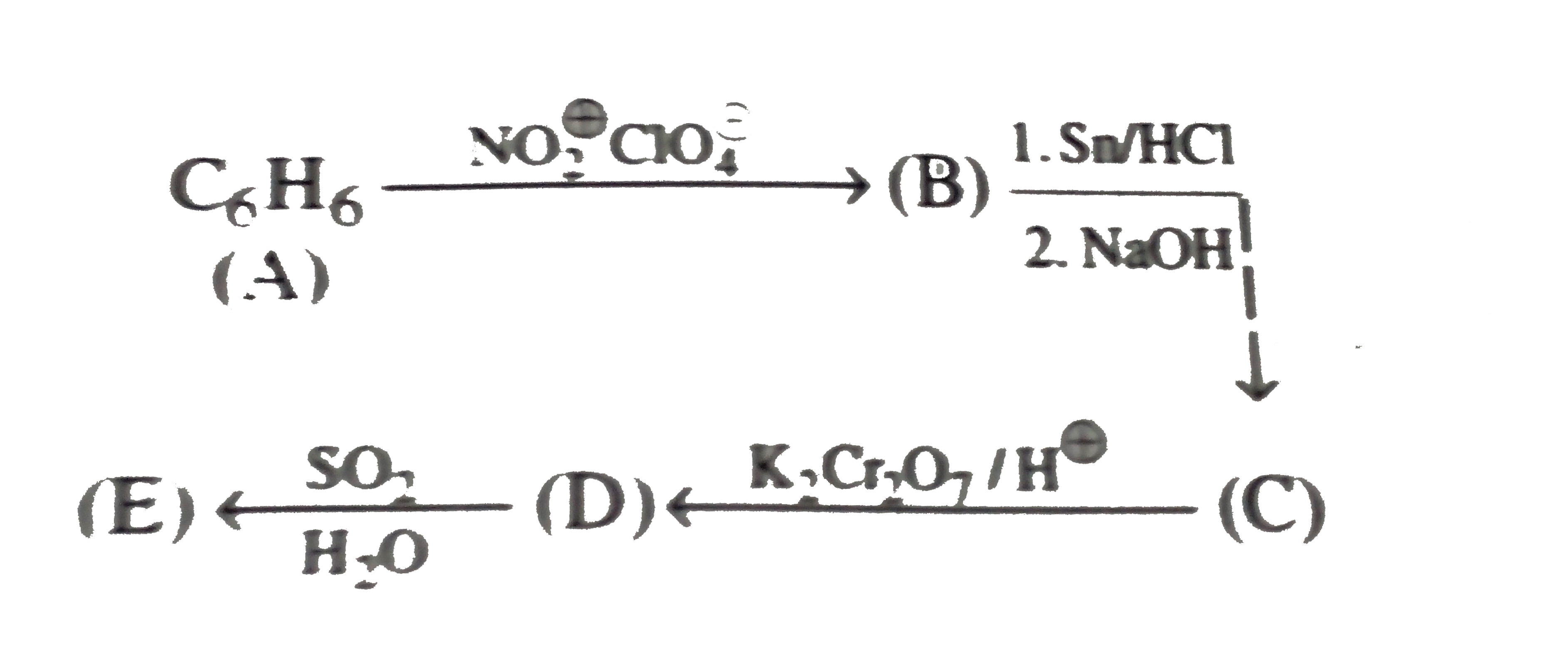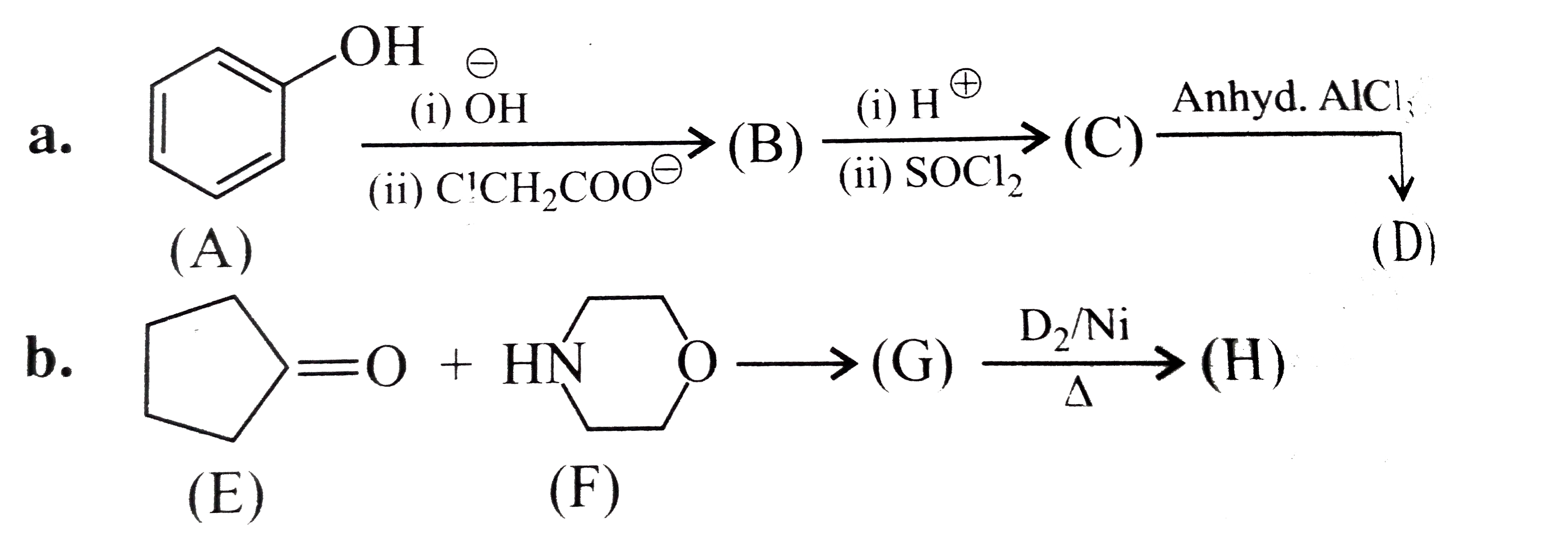Complete Solutions to Exercises Subjective of chapter ALCOHOL,PHENOL AND ETHERS of Class 12 book with complete answers and questions
| Class 12 | CHEMISTRY |
| Chapter | ALCOHOL,PHENOL AND ETHERS |
| CENGAGE CHEMISTRY | Exercises Subjective |
| Number Of Questions | 25 |
| Academic Year | 2023-24 |
Identify the following compounds :
i. `overset (C_(6)H_(6)) underset ((A))` `overset (2H_(2)SO_(4)) rarr` (B) `overset (1. NaOH, 540 K) underset (2. HCI) rarr` (C)
ii.
View SolutionIdentify A, B, and C,
i. Isomeric alcohols (A), (B), and (C) `(C_(5)H_(12)O)`.
ii. (A) and (B) react with chromic acid solution. (B) gives an acid (D).
iii. Reactivity with HBr is `C gt A gtgt B` . All give the same compound, `C_(5)H_(11)Br` (E).
iv. Only (A) is oxidised by NaOI.
View SolutionIdentify (A)

View Solution`C_(7)H_(14)` (A) decolourises `Br_(2)` in `C CI_(4)` and reacts with `Hg(OAc)_(2)` in THF `H_(2)O` following by reduction with `NaBH_(4)` to produce a resolvable compounds (B). (A) undergoes reductive ozonolysis to give the same compound (C) obtained by oxidation of hexan-3-ol with `KMnO_(4)` . Identify (A), (B), and (C).
View SolutionCompound (D), an isomer of (A) in Problem 4, reacts with `BH_(3)`. THF and then `H_(2)O_(2)//O^(-)H` to give chiral (E). Oxidation of (E) with `KMnO_(4)` or acid dichromate affords a chiral carboxylic acid, (F). Ozonolysis of (D) after reduction with Zn gives the same compound (G) obtained by oxidation of 2-methyl pentan-3-ol with `KMnO_(4)`. Identify (D), (E), (F) and (G).
View SolutionCompound (A), `C_(8)H_(6)NOBr`, is optically active. Reduction of (A) gives (B) which reacts with nitrouos acid to form (C), dihydric alcohol. Benzene sulphonyl chloride reacts with (B) to give a product soluble in NaOH. Hydrolysis of (A) gives (D) which is an optically active acid. (A) does not give any precipitate with aqueous `AgNO_(3)` . Controlled oxidation of (A) gives monobromo benzoic acid. Compound (A) on reaction with `Br_(2)//Fe` gives only one compound. Identify (A), (B), (C), and (D).
View SolutionIdentify A to E.

View SolutionAn organic compound (A) `(C_(8)H_(8)O_(3))` was insoluble in water, dilute HCI, and `NaHCO_(3)`. It was soluble in NaOH. A solution of (A) in dilute NaOH was boiled and steam distilled and distillate was reacted with NaOH to give a yellow precipitate. The alkaline residue is acidifield to give a solid (B) `(C_(7)H_(6)O_(3))`. (B) dissolves in aqueous `NaHCO_(3)` with the evolution of gas. Identify (A) and (B).
View SolutionNeutralisation of 30 gm of a mixture of acetic acid and phenol solutions required 100 ml of 2M sodium hydroxide solution. When the same mixture was treated with bromine water, `33.1` gm of precipitate was formed. Determine the mass percentage of acetic acid and phenol in the given solution.
View SolutionFind the structure of (A), `C_(10)H_(10)O_(2)`, a sweet-smelling liquid that has the following properties: It does not dissolve in NaOH or given a colour with `FeCI_(3)` , it adds one equivalent of `H_(2)` on catalytic hydrogenation. Reductive ozonolysis affords `H_(2)C=O` and `C_(9)H_(8)O_(3)` (B) that gives a positive Tollens test. Oxidation of (A) with `KMnO_(4)` gives an acid (C) (MW = 166) which gives no colour with `FeCI_(3)`. When (C) is refluxed with concentrated HI, `H_(2)C=O` and 3,4-dihydroxybenzoic acid are isolated and identified.
View Solutiona. Isomers (A) and (B), `C_(10)H_(12)O`, are isolated form the oil of bay leaf. They are insoluble in aq. NaOH and decolourise `Br_(2)//CCI_(4)` and `KMnO_(4)`. Each is vigorously oxidised to p-anisic acid, `(p-MeOC_(6)H_(4)COOH)`. Ozonolysis (A) and (B). Identify A and B
View SolutionAn aromatic compound (A), `C_(7)H_(5)NO_(2)CI_(2)` on reduction with `Sn//HCI` gives (G), which on reaction with `NaNO_(2)//HCI` gives (B). Compound (B) does not form a dye with `beta`-naphthol. However, (B) gives red colour with ceric ammonium nitrate and on oxidation gives an acid (D) of equivalent weight 191. Decarboxylation of (D) gives (E), which forms a mono nitro derivative (F) on nitrotion. Give the structures of (A) to (F) with proper reasoning.
View SolutionAn organic compound (A) gives opsitive Liebermann reaction and on treatment with `CHCI_(3)//KOH` followed by hydrolysis gives (B) and (C). Compound (B) gives colour with Schiff's reagent but not (C), which is steam volatile. (C ) on treatment with `LiAIH_(4)` gives (D), `C_(7)H_(8)O_(2)`, which on oxidation gives (E). Compound (E) reacts with `(CH_(3)CO)_(2))O//CH_(3)COOH` to give a pain reliever (F). Give the structures of (A) to (F) with proper reasoning.
View SolutionTwo isomeric compounds, (A) and (B), have the same formula, `C_(11)H_(13)OCI`. Both are unsaturated, yield the same compound (C) on catalytic hydrogenation, and produce 4-chloro-3-ethoxybenzoic acid on vigorous oxidation. (A) exists in geometrical isomers, (D) and (E), but not (B). Give structures of (A) to (E) with proper reasoning.
View SolutionNirtobenzene is formed as the major product along with a minor product in the reaction of benzene with a hot mixture of nitric acid and sulphuric acid. The minor product consists of carbon `42.86%`, hydrogen `2.40%`, nitrogen `16.67%` and oxygen `38.07%`.
a. Calculate the empirical formula of the minor product.
b. When `5.5 g` of the minor product is dissolved in `45 g` of benzene, the boiling point of the solution is `1.84 C` higher than that of pure benzen. Calculate the molar mass of the minor product and determine its molecular and structural formulae. (Molar elevation constant of benzene is `2.53 K kg mol^(-1))`
View SolutionIdentify A, B, and C, in the following reaction.

View SolutionProvide a mechanism for the products (A) and (B). Which one will be the major product ?

View SolutionIdentify the substances (A) through (D) in a sequence.

Comment on `K_(a)` values of (B) and (C ).
View SolutionIdentify each of the following glucose derivative.
a. `A+5HIO_(4)rarr 4HCOOH+2HCHO`
b. `B+3HIO_(4)rarr 2HCOOH+2OHC--COOH`
View SolutionIf
 is treated with alkaline `NaN_(3)` and followed by reduction with `H_(2)//Pd` it gives an `alpha`-amino acid alanine `overset ((Me---CH---COOH))underset (NH_(2))underset (|)` . Explain the reaction.
is treated with alkaline `NaN_(3)` and followed by reduction with `H_(2)//Pd` it gives an `alpha`-amino acid alanine `overset ((Me---CH---COOH))underset (NH_(2))underset (|)` . Explain the reaction.
View SolutionConverst

View SolutionAssign the structure of (B), the principal organic product of the following reaction:

View SolutionWhen a mixture of t-butyl alcohol and and ethyl alcohol is heated with cons. `H_(2)SO_(4)`, a single ether product is obtained. Identify the product giving proper reasons.
View SolutionIdentify the major products (B) to (H).
a.
View SolutionWhen pent-4-en-1-ol is treated with aqueous `Br_(2)//O^(-)H`, a cyclic bromo ether is rather than the expected bromohydrin. Propose a sutiable mechanism for the above.
View Solution
Exercises Subjective questions and complete solutions for chapter ALCOHOL,PHENOL AND ETHERS of CENGAGE CHEMISTRY (ENGLISH) of Class 12
All Exercises from CENGAGE CHEMISTRY Class 12 CHEMISTRY ALCOHOL,PHENOL AND ETHERS
- Archives Analytical And Descriptive
- Archives Assertion-Reasoning
- Archives Fill In The Blanks
- Archives Linked Comprehension
- Archives Multiple Correct
- Archives Single Correct
- Archives True/False
- Exercises Assertion-Reasoning
- Exercises Concept Application
- Exercises Linked Comprehension
- Exercises Multiple Correct
- Exercises Single Correct
- Exercises Subjective
- Illustration
- Solved Examples